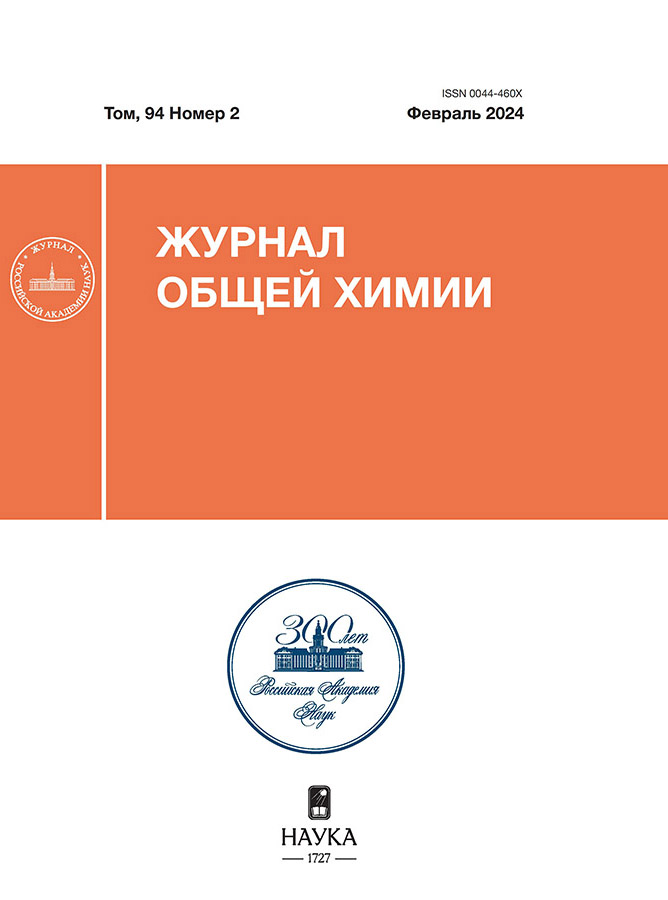Electron Transfer in Reaction of 12H-Quinoxalino[2,3-b]phenoxazines with π-Acceptors
- Авторлар: Ivakhnenko E.P.1, Knyazev P.A.1, Makarova N.I.1, Demidov O.P.2, Starikov A.G.1, Minkin V.I.1
-
Мекемелер:
- Institute of Physical and Organic Chemistry, Southern Federal University
- North-Caucasus Federal University
- Шығарылым: Том 94, № 2 (2024)
- Беттер: 216-224
- Бөлім: Articles
- URL: https://bulletin.ssaa.ru/0044-460X/article/view/667181
- DOI: https://doi.org/10.31857/S0044460X24020072
- EDN: https://elibrary.ru/GVAIUD
- ID: 667181
Дәйексөз келтіру
Аннотация
Using the reaction of 2,4-di-(tert-butyl)-12-(4-methoxyphenyl)-10-methoxy-12H-quinoxalino[2,3-b]phenoxazine with π-electron acceptors such as tetracyanoquinodimethane and 3,6-di-(tert-butyl)-o-quinone) as an example it was shown that derivatives of this N,O-pentaheterocyclic system are effective electron donors that, under mild conditions, carry out electron transfer reactions with the formation of stable cation and anion radical structures.
Толық мәтін
Авторлар туралы
E. Ivakhnenko
Institute of Physical and Organic Chemistry, Southern Federal University
Хат алмасуға жауапты Автор.
Email: ivakhnenko@sfedu.ru
ORCID iD: 0000-0003-0338-6466
Ресей, Rostov-on-Don, 344091
P. Knyazev
Institute of Physical and Organic Chemistry, Southern Federal University
Email: ivakhnenko@sfedu.ru
ORCID iD: 0000-0001-6627-8329
Ресей, Rostov-on-Don, 344091
N. Makarova
Institute of Physical and Organic Chemistry, Southern Federal University
Email: ivakhnenko@sfedu.ru
ORCID iD: 0000-0002-7196-9842
Ресей, Rostov-on-Don, 344091
O. Demidov
North-Caucasus Federal University
Email: ivakhnenko@sfedu.ru
ORCID iD: 0000-0002-3586-0487
Ресей, Stavropol, 355017
A. Starikov
Institute of Physical and Organic Chemistry, Southern Federal University
Email: ivakhnenko@sfedu.ru
ORCID iD: 0000-0002-5613-6308
Ресей, Rostov-on-Don, 344091
V. Minkin
Institute of Physical and Organic Chemistry, Southern Federal University
Email: ivakhnenko@sfedu.ru
ORCID iD: 0000-0001-6096-503X
Ресей, Rostov-on-Don, 344091
Әдебиет тізімі
- Gruntz G., Lee H., Hirsch L., Castet F., Toupance T., Briseno A., Nicolas Y. // Adv. Electron. Mater. 2015. Article no. 1500072. doi: 10.1002/aelm.201500072
- Tanaka T., Ashida T., Matsumoto S. // Chem. Lett. 2011. Vol. 40. P. 573. doi: 10.1246/cl.2011.573
- Sharma K., Sharma V., Sharma S.S. // Nanoscale Res. Lett. 2018. Vol. 13. P. 381. doi: 10.1186/s11671-018-2760-6
- Wadsworth A., Moser M., Marks A., Little M.S., Gasparini N., Brabec C.J., Baran D., McCulloch I. // Chem. Soc. Rev. 2019. Vol. 48. P. 1596. doi: 10.1039/c7cs00892a
- Ivakhnenko E.P., Knyazev P.A., Omelichkin N.I., Makarova N.I., Starikov A.G., Aleksandrov A.E., Ezhov A.V., Tameev A.R., Demidov O.P., Minkin V.I. // Dyes Pigm. 2022. Vol. 197. P. 109848. doi 10.1016/ j.dyepig.2021.109848
- Mishra A. // Energy Environ. Sci. 2020. Vol. 13. P. 4738. doi: 10.1039/d0ee02461a
- Fu G., Wang T., Cai J., Shi J., Luo Z., Li G., Li X., Zhang Z., Yang S. // Org. Electronics. 2015. Vol. 18. P. 70. doi: 10.1016/j.orgel.2015.01.011
- Chen X.-K., Coropceanu V., Bredas J.-L. // Nature Commun. 2018. Vol. 9. P. 5295. doi: 10.1038/s41467-018-07707-8
- Hustings J., Bonné R., Cornelissen R., Morini F., Valcke R., Vandewal K., Manca J. // Front. Photon., Sec. Photovoltaic Materials and Devices. 2022. Vol. 3. doi: 10.3389/fphot.2022.1050189
- Haran N., Luz Z., Shporer M. // J. Am. Chem. Soc. 1974. Vol. 96. P. 4788. doi: 10.1021/ja00822a012
- Беспалов Б.П., Титов В.В. // Усп. xим. 1975. Т. 54. С. 2249.
- Melby L.R., Harder R.J., Hertler W.R., Mahler W., Benson R.E., Mochel W.E. // J. Am. Chem. Soc. 1962. Vol. 84. P. 3374. doi: 10.1021/ja00876a029
- Becke A.D. // J. Chem. Phys. 1993. Vol. 98. P. 5648. doi: 10.1063/1.464913
Қосымша файлдар


















